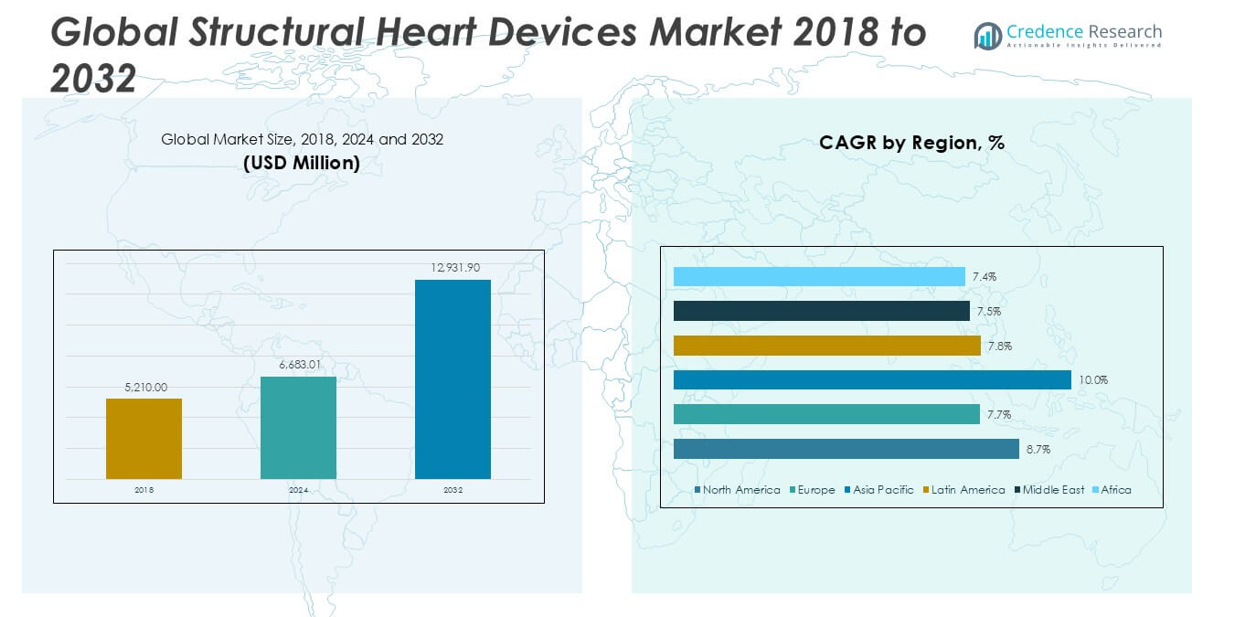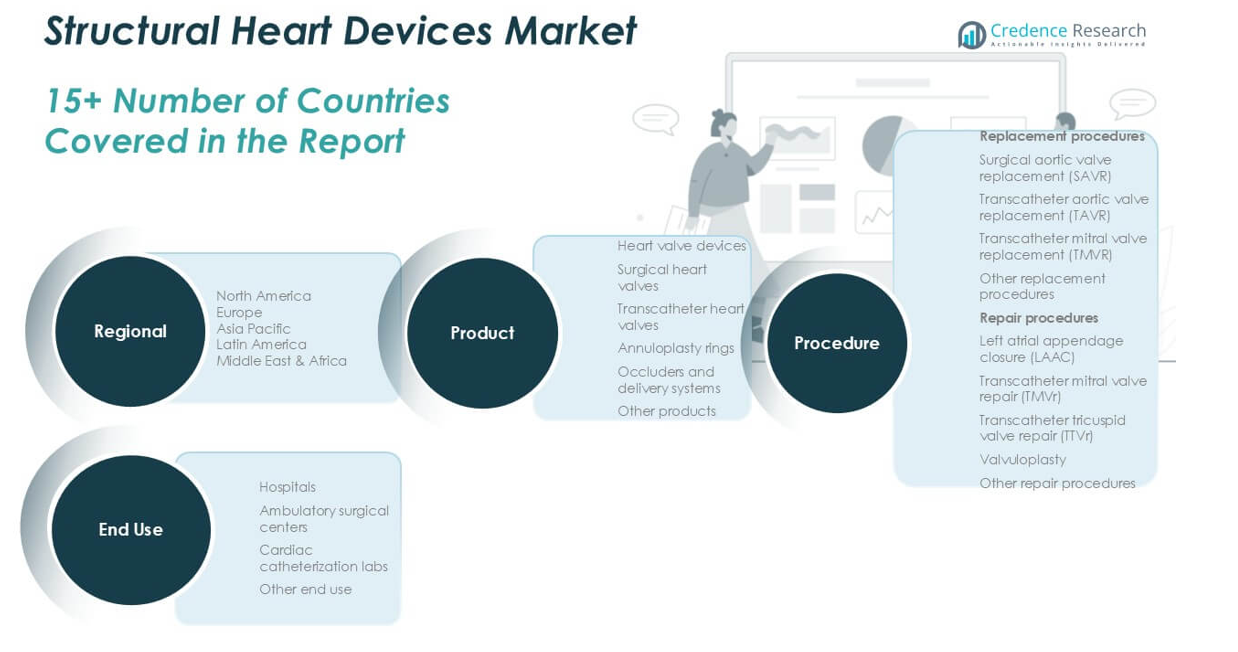CHAPTER NO. 1 :GENESIS OF THE MARKET
1.1 Market Prelude – Introduction & Scope
1.2 The Big Picture – Objectives & Vision
1.3 Strategic Edge – Unique Value Proposition
1.4 Stakeholder Compass – Key Beneficiaries
CHAPTER NO. 2 : EXECUTIVE LENS
2.1 Pulse of the Industry – Market Snapshot
2.2 Growth Arc – Revenue Projections (USD Million)
2.3. Premium Insights – Based on Primary Interviews
CHAPTER NO. 3 : STRUCTURAL HEART DEVICES MARKET FORCES & INDUSTRY PULSE
3.1 Foundations of Change – Market Overview
3.2 Catalysts of Expansion – Key Market Drivers
3.2.1 Momentum Boosters – Growth Triggers
3.2.2 Innovation Fuel – Disruptive Technologies
3.3 Headwinds & Crosswinds – Market Restraints
3.3.1 Regulatory Tides – Compliance Challenges
3.3.2 Economic Frictions – Inflationary Pressures
3.4 Untapped Horizons – Growth Potential & Opportunities
3.5 Strategic Navigation – Industry Frameworks
3.5.1 Market Equilibrium – Porter’s Five Forces
3.5.2 Ecosystem Dynamics – Value Chain Analysis
3.5.3 Macro Forces – PESTEL Breakdown
3.6 Price Trend Analysis
3.6.1 Regional Price Trend
3.6.2 Price Trend by product
CHAPTER NO. 4 :KEY INVESTMENT EPICENTER
4.1 Regional Goldmines – High-Growth Geographies
4.2 Product Frontiers – Lucrative Product Categories
4.3 Procedure Sweet Spots – Emerging Demand Segments
CHAPTER NO. 5: REVENUE TRAJECTORY & WEALTH MAPPING
5.1 Momentum Metrics – Forecast & Growth Curves
5.2 Regional Revenue Footprint – Market Share Insights
5.3 Segmental Wealth Flow – Product & Procedure Revenue
CHAPTER NO. 6 :TRADE & COMMERCE ANALYSIS
6.1.Import Analysis by Region
6.1.1. Global Structural Heart Devices Market Import Volume By Region
6.2.Export Analysis by Region
6.2.1. Global Structural Heart Devices Market Export Volume By Region
CHAPTER NO. 7 :COMPETITION ANALYSIS
7.1.Company Market Share Analysis
7.1.1. Global Structural Heart Devices Market: Company Market Share
7.1. Global Structural Heart Devices Market Company Volume Market Share
7.2. Global Structural Heart Devices Market Company Revenue Market Share
7.3.Strategic Developments
7.3.1.Acquisitions & Mergers
7.3.2. New Product Launch
7.3.3. Regional Expansion
7.4. Competitive Dashboard
7.5. Company Assessment Metrics, 2024
CHAPTER NO. 8 :STRUCTURAL HEART DEVICES MARKET – BY PRODUCT SEGMENT ANALYSIS
8.1.Structural Heart Devices Market Overview by Product Segment
8.1.1. Structural Heart Devices Market Volume Share By Product
8.1.2. Structural Heart Devices Market Revenue Share By Product
8.2. Heart Valve Devices
8.2.1Surgical Heart Valves
8.2.2Transcatheter Heart Valves
8.3. Annuloplasty Rings
8.4. Occluders and Delivery Systems
8.5.Other Products
CHAPTER NO. 9 :STRUCTURAL HEART DEVICES MARKET – BY PROCEDURE SEGMENT ANALYSIS
9.1.Structural Heart Devices Market Overview by Procedure Segment
9.1.1. Structural Heart Devices Market Volume Share By Procedure
9.1.2. Structural Heart Devices Market Revenue Share By Procedure
9.2. Replacement Procedures
9.2.1Surgical Aortic Valve Replacement (SAVR)
9.2.2 Transcatheter Aortic Valve Replacement (TAVR)
9.2.3 Transcatheter Mitral Valve Replacement (TMVR)
9.2.4 Other Replacement Procedures
9.3. Repair Procedures
9.3.1Left Atrial Appendage Closure (LAAC)
9.3.2 Transcatheter Mitral Valve Repair (Tmvr)
9.3.3 Transcatheter Tricuspid Valve Repair (Ttvr)
9.3.4 Valvuloplasty
9.3.5 Other Repair Procedures
CHAPTER NO. 10 :STRUCTURAL HEART DEVICES MARKET – BY END-USE SEGMENT ANALYSIS
10.1.Structural Heart Devices Market Overview by End-use Segment
10.1.1. Structural Heart Devices Market Volume Share By End-use
10.1.2. Structural Heart Devices Market Revenue Share By End-use
10.2. Hospitals
10.3. Ambulatory Surgical Centers
10.4. Cardiac Catheterization Labs
10.5. Other End Use
CHAPTER NO. 11 :STRUCTURAL HEART DEVICES MARKET – REGIONAL ANALYSIS
11.1.Structural Heart Devices Market Overview by Region Segment
11.1.1. Global Structural Heart Devices Market Volume Share By Region
11.1.2. Global Structural Heart Devices Market Revenue Share By Region
11.1.3.Regions
11.1.4.Global Structural Heart Devices Market Volume By Region
11.1.5.Global Structural Heart Devices Market Revenue By Region
11.1.6.Product
11.1.7.Global Structural Heart Devices Market Volume By Product
11.1.8.Global Structural Heart Devices Market Revenue By Product
11.1.9.Procedure
11.1.10. Global Structural Heart Devices Market Volume By Procedure
11.1.11. Global Structural Heart Devices Market Revenue By Procedure
11.1.12.End-use
11.1.13. Global Structural Heart Devices Market Volume By End-use
11.1.14. Global Structural Heart Devices Market Revenue By End-use
CHAPTER NO. 12 :NORTH AMERICA STRUCTURAL HEART DEVICES MARKET – COUNTRY ANALYSIS
12.1.North America Structural Heart Devices Market Overview by Country Segment
12.1.1.North America Structural Heart Devices Market Volume Share By Region
12.1.2. North America Structural Heart Devices Market Revenue Share By Region
12.2.North America
12.2.1.North America Structural Heart Devices Market Volume By Country
12.2.2.North America Structural Heart Devices Market Revenue By Country
12.2.3.Product
12.2.4.North America Structural Heart Devices Market Volume By Product
12.2.5.North America Structural Heart Devices Market Revenue By Product
12.2.6.Procedure
12.2.7.North America Structural Heart Devices Market Volume By Procedure
12.2.8. North America Structural Heart Devices Market Revenue By Procedure
12.2.9.End-use
12.2.10.North America Structural Heart Devices Market Volume By End-use
12.2.11.North America Structural Heart Devices Market Revenue By End-use
12.3.U.S.
12.4.Canada
12.5.Mexico
CHAPTER NO. 13 :EUROPE STRUCTURAL HEART DEVICES MARKET – COUNTRY ANALYSIS
13.1. Europe Structural Heart Devices Market Overview by Country Segment
13.1.1. Europe Structural Heart Devices Market Volume Share By Region
13.1.2. Europe Structural Heart Devices Market Revenue Share By Region
13.2.Europe
13.2.1.Europe Structural Heart Devices Market Volume By Country
13.2.2.Europe Structural Heart Devices Market Revenue By Country
13.2.3.Product
13.2.4.Europe Structural Heart Devices Market Volume By Product
13.2.5.Europe Structural Heart Devices Market Revenue By Product
13.2.6.Procedure
13.2.7. Europe Structural Heart Devices Market Volume By Procedure
13.2.8. Europe Structural Heart Devices Market Revenue By Procedure
13.2.9.End-use
13.2.10. Europe Structural Heart Devices Market Volume By End-use
13.2.11. Europe Structural Heart Devices Market Revenue By End-use
13.3.UK
13.4.France
13.5.Germany
13.6.Italy
13.7.Spain
13.8.Russia
13.9. Rest of Europe
CHAPTER NO. 14 :ASIA PACIFIC STRUCTURAL HEART DEVICES MARKET – COUNTRY ANALYSIS
14.1.Asia Pacific Structural Heart Devices Market Overview by Country Segment
14.1.1.Asia Pacific Structural Heart Devices Market Volume Share By Region
14.1.2.Asia Pacific Structural Heart Devices Market Revenue Share By Region
14.2.Asia Pacific
14.2.1. Asia Pacific Structural Heart Devices Market Volume By Country
14.2.2.Asia Pacific Structural Heart Devices Market Revenue By Country
14.2.3.Product
14.2.4.Asia Pacific Structural Heart Devices Market Volume By Product
14.2.5.Asia Pacific Structural Heart Devices Market Revenue By Product
14.2.6.Procedure
14.2.7.Asia Pacific Structural Heart Devices Market Volume By Procedure
14.2.8.Asia Pacific Structural Heart Devices Market Revenue By Procedure
14.2.9.End-use
14.2.10.Asia Pacific Structural Heart Devices Market Volume By End-use
14.2.11.Asia Pacific Structural Heart Devices Market Revenue By End-use
14.3.China
14.4.Japan
14.5.South Korea
14.6.India
14.7.Australia
14.8.Southeast Asia
14.9. Rest of Asia Pacific
CHAPTER NO. 15 : LATIN AMERICA STRUCTURAL HEART DEVICES MARKET – COUNTRY ANALYSIS
15.1.Latin America Structural Heart Devices Market Overview by Country Segment
15.1.1.Latin America Structural Heart Devices Market Volume Share By Region
15.1.2.Latin America Structural Heart Devices Market Revenue Share By Region
15.2. Latin America
15.2.1. Latin America Structural Heart Devices Market Volume By Country
15.2.2.Latin America Structural Heart Devices Market Revenue By Country
15.2.3.Product
15.2.4. Latin America Structural Heart Devices Market Volume By Product
15.2.5. Latin America Structural Heart Devices Market Revenue By Product
15.2.6.Procedure
15.2.7.Latin America Structural Heart Devices Market Volume By Procedure
15.2.8.Latin America Structural Heart Devices Market Revenue By Procedure
15.2.9.End-use
15.2.10.Latin America Structural Heart Devices Market Volume By End-use
15.2.11.Latin America Structural Heart Devices Market Revenue By End-use
15.3.Brazil
15.4.Argentina
15.5.Rest of Latin America
CHAPTER NO. 16 : MIDDLE EAST STRUCTURAL HEART DEVICES MARKET – COUNTRY ANALYSIS
16.1.Middle East Structural Heart Devices Market Overview by Country Segment
16.1.1.Middle East Structural Heart Devices Market Volume Share By Region
16.1.2. Middle East Structural Heart Devices Market Revenue Share By Region
16.2.Middle East
16.2.1. Middle East Structural Heart Devices Market Volume By Country
16.2.2.Middle East Structural Heart Devices Market Revenue By Country
16.2.3.Product
16.2.4.Middle East Structural Heart Devices Market Volume By Product
16.2.5.Middle East Structural Heart Devices Market Revenue By Product
16.2.6.Procedure
16.2.7.Middle East Structural Heart Devices Market Volume By Procedure
16.2.8.Middle East Structural Heart Devices Market Revenue By Procedure
16.2.9. End-use
16.2.10.Middle East Structural Heart Devices Market Volume By End-use
16.2.11. Middle East Structural Heart Devices Market Revenue By End-use
16.3.GCC Countries
16.4. Israel
16.5. Turkey
16.6.Rest of Middle East
CHAPTER NO. 17 : AFRICA STRUCTURAL HEART DEVICES MARKET – COUNTRY ANALYSIS
17.1. Africa Structural Heart Devices Market Overview by Country Segment
17.1.1.Africa Structural Heart Devices Market Volume Share By Region
17.1.2. Africa Structural Heart Devices Market Revenue Share By Region
17.2. Africa
17.2.1.Africa Structural Heart Devices Market Volume By Country
17.2.2.Africa Structural Heart Devices Market Revenue By Country
17.2.3.Product
17.2.4.Africa Structural Heart Devices Market Volume By Product
17.2.5.Africa Structural Heart Devices Market Revenue By Product
17.2.6.Procedure
17.2.7. Africa Structural Heart Devices Market Volume By Procedure
17.2.8. Africa Structural Heart Devices Market Revenue By Procedure
17.2.9.End-use
17.2.10. Africa Structural Heart Devices Market Volume By End-use
17.2.11. Africa Structural Heart Devices Market Revenue By End-use
17.3. South Africa
17.4.Egypt
17.5.Rest of Africa
CHAPTER NO. 18 :COMPANY PROFILES
18.1. Abbott
18.1.1.Company Overview
18.1.2.Product Portfolio
18.1.3.Financial Overview
18.1.4.Recent Developments
18.1.5.Growth Strategy
18.1.6.SWOT Analysis
18.2. AtriCure
18.3. BIOMERICS
18.4. Boston Scientific
18.5. BRAILE
18.6. CryoLife
18.7. Edwards
18.8. JENAVALVE
18.9. LEPU MEDICAL
18.10. LivaNova
18.11. Medtronic
18.12. NUMED





